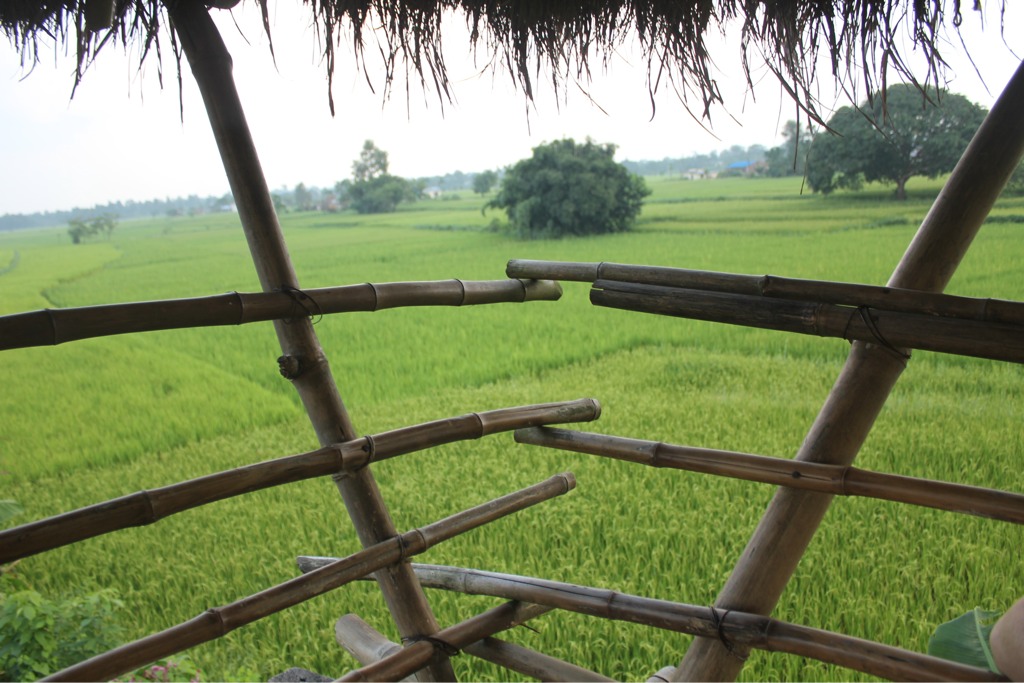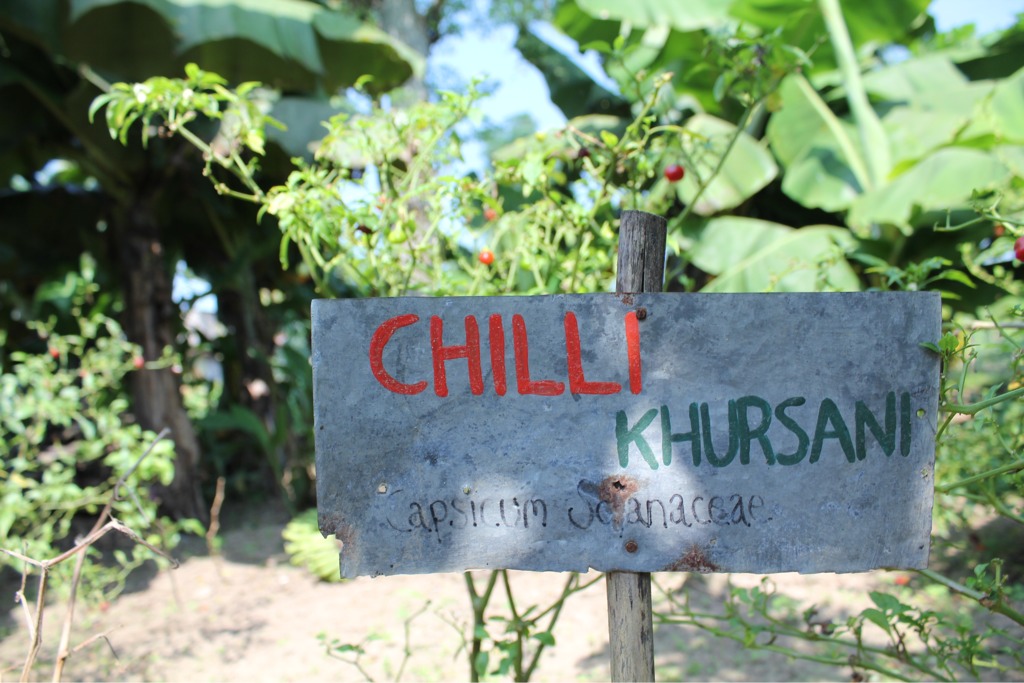 After a six hour bus ride spent swerving through the rocky cliff passes and easing our way down into the Terai jungle territory of southern Nepal, we stopped in Narayangarh, a small city north of our destination. We would pile into a Toyota minibus, fit with with a Suzuki windshield screen topper, and head for approximately 17km (or 10.5 miles) towards Sitamai Eco Farm. It would take a full hour. This is due to the condition of the roads, which are really just broad hosts for potholes, pedestrians, motorcyclists, buffalo and people carrying the days harvest home on or by their noggins. With the frenetic wildness of Kathmandu behind us, we entered the steamy (yet, as visually stimulating) calm of village life. It is still impossible to pinpoint the exact name of the village where the farm is and, truly, it may not actually have one that is officially on any map. For technical purposes, we will refer to it as Sitamai, near Patihani.
After a six hour bus ride spent swerving through the rocky cliff passes and easing our way down into the Terai jungle territory of southern Nepal, we stopped in Narayangarh, a small city north of our destination. We would pile into a Toyota minibus, fit with with a Suzuki windshield screen topper, and head for approximately 17km (or 10.5 miles) towards Sitamai Eco Farm. It would take a full hour. This is due to the condition of the roads, which are really just broad hosts for potholes, pedestrians, motorcyclists, buffalo and people carrying the days harvest home on or by their noggins. With the frenetic wildness of Kathmandu behind us, we entered the steamy (yet, as visually stimulating) calm of village life. It is still impossible to pinpoint the exact name of the village where the farm is and, truly, it may not actually have one that is officially on any map. For technical purposes, we will refer to it as Sitamai, near Patihani.
The view above, of those never ending rice fields, can only be experienced from the top of a twenty foot high bamboo structure built in the back corner of the small, well utilized property. It was one of the first places we sat and settled our minds and bodies after the day's travel and is a pretty magical experience every time.
The farm is the family property of Padam and Pramila Ghimire, and is home to the two of them, their two children (Dipika and Dependre), and Padam's mother, known to us only as Ama. Pramila and the children live part time in Kathmandu, where they attend school and she manages her myriad projects - a school near Sitamai, a volunteering non-profit, and planning another farm which aims to employ disadvantaged women. Our timing was perfect for sharing the time and space with the whole family, as the national holiday of Dasain was taking place during the exact two weeks we would be there. More on that later, though.


There are countless essentials growing all around the property, which are always being utilized for the twice daily dal bhat meals. Besides the lentils and rice, there is always tarkani (vegetables) and pickle, as well as fresh buffalo curd...from the feisty buffalo (named Martial Art, by Padam who milks her each morning at 6am). There was also a big, beautiful Mango tree, Neem tree, and Tulsi plants, which are considered holy in the Hindu religion. Both neem and tulsi are considered to be incredibly healing; the former (and first pictured below) is puckeringly bitter and the latter more gentle but tongue numbing. Eli and I would eat one in the morning with milk chiya (masala tea) for good measure.


Speaking of the buffalo, there is a bio-gas system set in place which utilizes the buffalo and human waste. The toilets feed underground directly into a holding tank and the buffalo dung is collected each day in a nifty mixer (lovely smelling job, really), which goes to the same tank. Somehow, there is a siphoning off of the natural gases emitted by it all and it is brought via underground pipe to fuel the cook top in the kitchen. Three very important things: (1) this is not unique to this farm - almost everyone in the village here, and throughout Nepal, has a buffalo (or a few) and bio-gas systems are gaining popularity, though still expensive. (2) having this system helps ensure that the main source of cooking is not firewood, which is damaging to lungs and the shrinking landscape. (3) Pramila just dug right in and collected the dung with her bare hands, laughing kindly at me while i tried to find a shovel. In the end I dumped the buckets and mixed while she collected. It balanced out well.
Below is the buffalo waste collection mixer, where you combine it with urine or water to make a liquid, and Padam (who didn't usually wear that amazing hat) explaining how the system works while Eli stands on top of a main collection tank. Next to all of this were the three compost piles, which didn't smell as bad as one might imagine in the heat.


Due to the weather being just post rainy season, with mid-day temperatures reaching around 36C (97F), the best working times were from about 5am to 9am and then again in the early evening. We managed to turn over a few new beds, replant some spinach, broccoli and cabbage, fix a tower step, and help with many meals. We also learned how to weave a local plant into small brooms and happened to really enjoy it. We manufactured about 40 of them, which the family could sell for approximately 50 Nepali rupees (64 cents USD) a piece, a decent additional income. Within and through all of this, the ever-present echo of Pramila's reminder on how to approach our Sitamai time floated in the air: Everything slowly, slowly. We will take this, and so much more, with us - onward in self-sustainability and life in general.
Location:Ganganagar, Chitawan National Park, Nepal
 After a six hour bus ride spent swerving through the rocky cliff passes and easing our way down into the Terai jungle territory of southern Nepal, we stopped in Narayangarh, a small city north of our destination. We would pile into a Toyota minibus, fit with with a Suzuki windshield screen topper, and head for approximately 17km (or 10.5 miles) towards Sitamai Eco Farm. It would take a full hour. This is due to the condition of the roads, which are really just broad hosts for potholes, pedestrians, motorcyclists, buffalo and people carrying the days harvest home on or by their noggins. With the frenetic wildness of Kathmandu behind us, we entered the steamy (yet, as visually stimulating) calm of village life. It is still impossible to pinpoint the exact name of the village where the farm is and, truly, it may not actually have one that is officially on any map. For technical purposes, we will refer to it as Sitamai, near Patihani.
After a six hour bus ride spent swerving through the rocky cliff passes and easing our way down into the Terai jungle territory of southern Nepal, we stopped in Narayangarh, a small city north of our destination. We would pile into a Toyota minibus, fit with with a Suzuki windshield screen topper, and head for approximately 17km (or 10.5 miles) towards Sitamai Eco Farm. It would take a full hour. This is due to the condition of the roads, which are really just broad hosts for potholes, pedestrians, motorcyclists, buffalo and people carrying the days harvest home on or by their noggins. With the frenetic wildness of Kathmandu behind us, we entered the steamy (yet, as visually stimulating) calm of village life. It is still impossible to pinpoint the exact name of the village where the farm is and, truly, it may not actually have one that is officially on any map. For technical purposes, we will refer to it as Sitamai, near Patihani.





